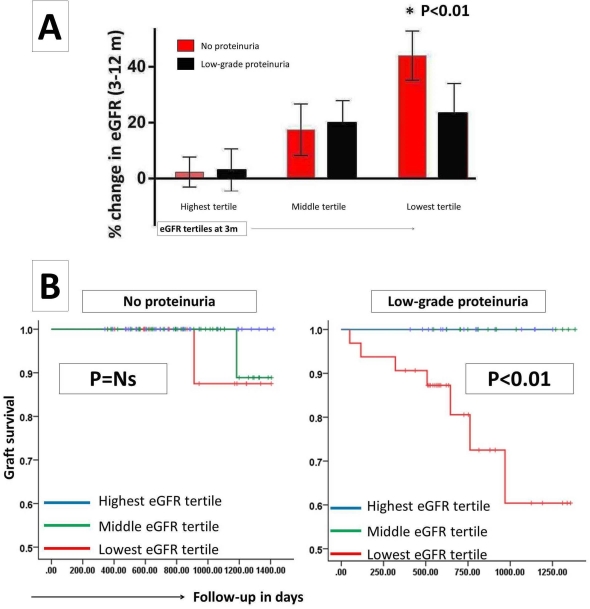Absence of Low-Grade Proteinuria Is Associated With Improved Outcomes in Patients With Worse 3 Month Graft Function in Renal Transplantation
1Leeds Teaching Hospitals, Leeds, United Kingdom
2University of Pittsburgh, Pittsburgh.
Meeting: 2015 American Transplant Congress
Abstract number: B119
Keywords: Graft failure, Proteinuria
Session Information
Session Name: Poster Session B: Kidney Complications: Late Graft Failure
Session Type: Poster Session
Date: Sunday, May 3, 2015
Session Time: 5:30pm-6:30pm
 Presentation Time: 5:30pm-6:30pm
Presentation Time: 5:30pm-6:30pm
Location: Exhibit Hall E
Low-grade proteinuria has been shown to be associated with adverse outcomes after renal transplantation. However most patients with proteinuria have worse eGFR and this interaction may potentially contribute to the adverse outcomes noted so far. In this study, we have analyzed low-grade proteinuria at 3 months post-transplantation with emphasis on early renal function.
164 patients who were transplanted between2011-13 were included in the analysis. Low-grade proteinuria was defined as urinary protein creatinine ratio>25 (250mg/day). Patients were also divided into tertiles based on their eGFR at 3 months. Percentage change in eGFR was calculated between 3 and 12 months for the tertiles of GFR stratified by the presence of proteinuria. Also graft survival was analyzed over a mean follow-up of 800 days.
Of the 164 patients included in the analysis, 65 had early low-grade proteinuria. These patients had significantly worse overall graft survival (hazard ratio 8.303, 95% CI 1.356 to 37.27, p = 0.02). When patients with and without proteinuria were stratified into tertiles by their eGFR at 3 months, absence of proteinuria was associated with a significant improvement in eGFR from 3-12 months post-transplantation in those within the lowest eGFR tertile group (worse renal function) when compared to patients with proteinuria (Fig-1A). In addition, when graft survival was examined within the eGFR tertiles, low 3 month eGFR (lowest tertile group) was associated with significantly worse graft survival only in patients with low-grade proteinuria (Fig-1B).
In conclusion, low-grade proteinuria risk stratifies patients with early renal dysfunction. Importantly absence of proteinuria is associated with a significant improvement in eGFR by 12 months post-transplant a finding which may potentially explain the improved graft survival noted in this group of patients despite early poor renal function.

To cite this abstract in AMA style:
Seitz A, Cherukuri A, Baker R. Absence of Low-Grade Proteinuria Is Associated With Improved Outcomes in Patients With Worse 3 Month Graft Function in Renal Transplantation [abstract]. Am J Transplant. 2015; 15 (suppl 3). https://atcmeetingabstracts.com/abstract/absence-of-low-grade-proteinuria-is-associated-with-improved-outcomes-in-patients-with-worse-3-month-graft-function-in-renal-transplantation/. Accessed December 14, 2025.« Back to 2015 American Transplant Congress
